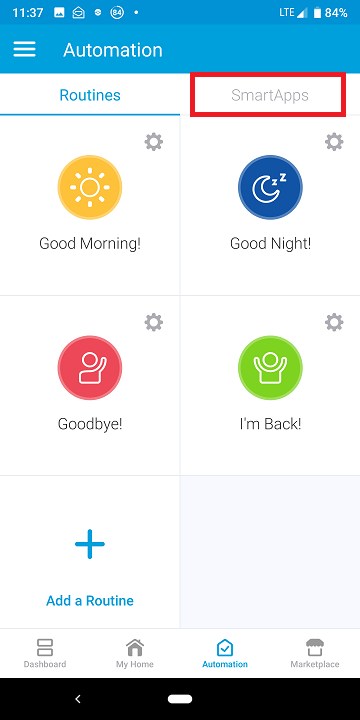

- #SMARTTHINGS DEVICE HANDLER SEND MESSAGE TO CALLING SMARTAPP INSTALL#
- #SMARTTHINGS DEVICE HANDLER SEND MESSAGE TO CALLING SMARTAPP CODE#
The code we are using will create a device that will be a virtual switch and contact sensor in one. We are going to use some code someone has already written so we want to create From Code. Next, you should see the Create New Device Handler screen. This will take you to your list of device handlers.

Then, click Next.Įventually, you should end up on a screen that looks like the screenshot below. If this is your first time, you’ll have to agree to some terms and conditions by checking a box. If you already have your SmartThings set up, you should already have a Samsung account.

Go to Click on Login in the upper right hand corner. Then paste (ctrl-v) to your New Device Handler Select all text (ctrl-a) and copy (ctrl-c). After that, creating more only requires a couple minutes each. If you follow this tutorial, you should be able to have your first routine up and running in about 20 minutes.

Create an Alexa routine that is triggered by the virtual sensor.Create a virtual switch/sensor in SmartThings.And, in my experience it’s quite reliable. It may seem like it’s a bit of a hack (because it is), but it works well. It let’s you trigger an Alexa routine with basically any SmartThings action instead of just the sensor trigger. The method in this tutorial takes advantage of that option. Recently, Alexa added an option that allows certain types of sensors to trigger Alexa routines (this only works for people in the US and UK…don’t ask me why that is). This tutorial will teach you a method to make any device that can be controlled by Alexa also be controllable by Samsung SmartThings. The SmartThings’ automations are more powerful so wouldn’t it be great if we could link these two universes together? Many smart home products are compatible with Alexa, but far fewer are directly compatible with Samsung SmartThings hub. If you have any insight into why, we’d love to hear from you. For some currently unknown reason this tutorial seems to work for some people but not for others. I just don’t see a way of doing that when I start building a piston.UPDATED : Please read the comments section.
#SMARTTHINGS DEVICE HANDLER SEND MESSAGE TO CALLING SMARTAPP INSTALL#
Of course, the simple answer is for me to follow through with the rest of the project, and install his Pushbullet Notifier, but I was hoping to use webCoRE for that. In my testing, it did indeed create a viable ‘thing’ in SmartThings for the Pushbullet endpoint that I chose in the SmartApp, and the test that I sent to it from within the SmartApp did indeed get there. In my case, I only installed the Device Handler and the Service Manager (Connect) SmartApp, because I want to use webCoRE to do the message sending. This is the SmartApp that is used to send messages to the Pushbullet endpoints via their corresponding, newly created ‘things’ in SmartThings. This is the SmartApp that takes the Pushbullet API, and uses it to create a ‘thing’ in SmartThings for the desired Pushbullet endpoint. This is the code used to create a ‘thing’ in SmartThings for each Pushbullet endpoint desired.


 0 kommentar(er)
0 kommentar(er)
